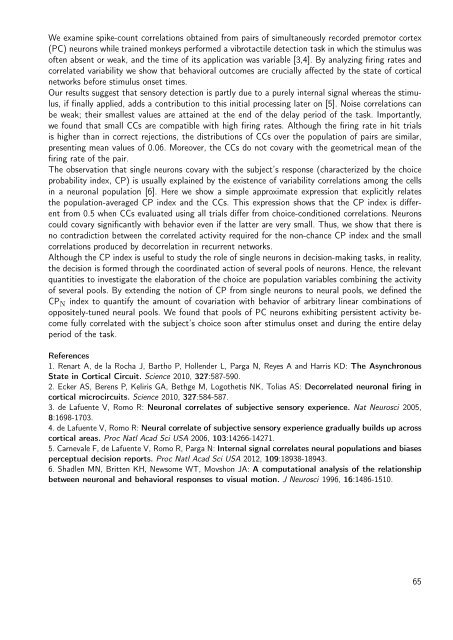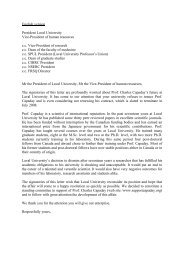Untitled - Laboratory of Neurophysics and Physiology
Untitled - Laboratory of Neurophysics and Physiology
Untitled - Laboratory of Neurophysics and Physiology
Create successful ePaper yourself
Turn your PDF publications into a flip-book with our unique Google optimized e-Paper software.
We examine spike-count correlations obtained from pairs <strong>of</strong> simultaneously recorded premotor cortex<br />
(PC) neurons while trained monkeys performed a vibrotactile detection task in which the stimulus was<br />
<strong>of</strong>ten absent or weak, <strong>and</strong> the time <strong>of</strong> its application was variable [3,4]. By analyzing firing rates <strong>and</strong><br />
correlated variability we show that behavioral outcomes are crucially affected by the state <strong>of</strong> cortical<br />
networks before stimulus onset times.<br />
Our results suggest that sensory detection is partly due to a purely internal signal whereas the stimulus,<br />
if finally applied, adds a contribution to this initial processing later on [5]. Noise correlations can<br />
be weak; their smallest values are attained at the end <strong>of</strong> the delay period <strong>of</strong> the task. Importantly,<br />
we found that small CCs are compatible with high firing rates. Although the firing rate in hit trials<br />
is higher than in correct rejections, the distributions <strong>of</strong> CCs over the population <strong>of</strong> pairs are similar,<br />
presenting mean values <strong>of</strong> 0.06. Moreover, the CCs do not covary with the geometrical mean <strong>of</strong> the<br />
firing rate <strong>of</strong> the pair.<br />
The observation that single neurons covary with the subject’s response (characterized by the choice<br />
probability index, CP) is usually explained by the existence <strong>of</strong> variability correlations among the cells<br />
in a neuronal population [6]. Here we show a simple approximate expression that explicitly relates<br />
the population-averaged CP index <strong>and</strong> the CCs. This expression shows that the CP index is different<br />
from 0.5 when CCs evaluated using all trials differ from choice-conditioned correlations. Neurons<br />
could covary significantly with behavior even if the latter are very small. Thus, we show that there is<br />
no contradiction between the correlated activity required for the non-chance CP index <strong>and</strong> the small<br />
correlations produced by decorrelation in recurrent networks.<br />
Although the CP index is useful to study the role <strong>of</strong> single neurons in decision-making tasks, in reality,<br />
the decision is formed through the coordinated action <strong>of</strong> several pools <strong>of</strong> neurons. Hence, the relevant<br />
quantities to investigate the elaboration <strong>of</strong> the choice are population variables combining the activity<br />
<strong>of</strong> several pools. By extending the notion <strong>of</strong> CP from single neurons to neural pools, we defined the<br />
CP N index to quantify the amount <strong>of</strong> covariation with behavior <strong>of</strong> arbitrary linear combinations <strong>of</strong><br />
oppositely-tuned neural pools. We found that pools <strong>of</strong> PC neurons exhibiting persistent activity become<br />
fully correlated with the subject’s choice soon after stimulus onset <strong>and</strong> during the entire delay<br />
period <strong>of</strong> the task.<br />
References<br />
1. Renart A, de la Rocha J, Bartho P, Hollender L, Parga N, Reyes A <strong>and</strong> Harris KD: The Asynchronous<br />
State in Cortical Circuit. Science 2010, 327:587-590.<br />
2. Ecker AS, Berens P, Keliris GA, Bethge M, Logothetis NK, Tolias AS: Decorrelated neuronal firing in<br />
cortical microcircuits. Science 2010, 327:584-587.<br />
3. de Lafuente V, Romo R: Neuronal correlates <strong>of</strong> subjective sensory experience. Nat Neurosci 2005,<br />
8:1698-1703.<br />
4. de Lafuente V, Romo R: Neural correlate <strong>of</strong> subjective sensory experience gradually builds up across<br />
cortical areas. Proc Natl Acad Sci USA 2006, 103:14266-14271.<br />
5. Carnevale F, de Lafuente V, Romo R, Parga N: Internal signal correlates neural populations <strong>and</strong> biases<br />
perceptual decision reports. Proc Natl Acad Sci USA 2012, 109:18938-18943.<br />
6. Shadlen MN, Britten KH, Newsome WT, Movshon JA: A computational analysis <strong>of</strong> the relationship<br />
between neuronal <strong>and</strong> behavioral responses to visual motion. J Neurosci 1996, 16:1486-1510.<br />
65



